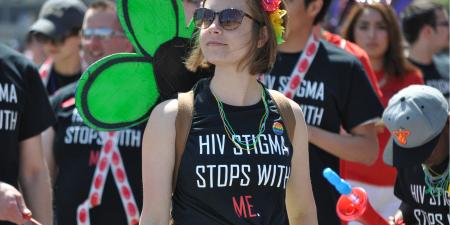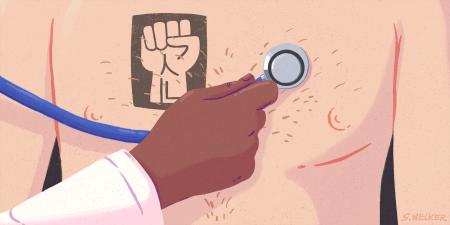Abstract
This case and commentary considers how organizations should respond to overt racism expressed by patients. The article considers the nature and scope of organizations’ responsibilities to train both professional and nonprofessional staff and to enact zero-tolerance policies to address expressions of discrimination.
Case
Dr C, an African American, is in her final year of an internal medicine residency. She reports to the emergency department to examine a middle-aged white woman injured in a car accident. The patient appears in stable condition but likely requires further medical testing. In the midst of the examination, the patient blurts out, “Isn’t there another doctor who can do this? I’d rather have a white doctor.” Dr C, shocked but not surprised, asks the patient if she wants the examination to continue and the patient acquiesces. The patient mutters under her breath, “I guess this is the way the world is going.” Dr C pretends to ignore the comment and continues the examination. The attending staff physician is an older white male, well respected in the organization. He observes the interaction and stands by quietly, allowing the examination to be completed. Upon leaving the patient’s room, the discussion among clinicians focuses exclusively on which tests are to be ordered, leaving the matter of the patient’s remarks unaddressed.
Commentary
That racism exists in health care settings should surprise no one—it exists in all domains of contemporary life. What is surprising is just how little racism is formally addressed in medicine.1 Noting this neglect, Johnstone and Kanitsaki ask, “Why has racism per se tended to be poorly addressed as an ethical issue in health care ethics discourse?”2 That is a good question. We know, for instance, that there are long-standing discrepancies in health care outcomes based in part on racial discrimination. These findings are not just historical facts but reflect contemporary conditions.3 Also well documented are racial assaults faced by health care practitioners of color, whether they be physicians, nurses, or other staff.4 Although inequalities in access to health care services and inequalities in health outcomes deserve our utmost attention, it is racial assaults on health care staff that we wish to focus our attention on here—from an ethical perspective. We are particularly interested in exploring not only the ethical problems that emerge when health care workers are exposed to racial discrimination by patients they attempt to treat but also, importantly, the conditions under which these ethical issues can be optimally addressed.
Need for Organizational Responses
Not uncommonly, health care practitioners of color are subject to overtly racist behaviors by patients—for example, when an individual or family specifically requests a white clinician. As Paul-Emile et al argue,5 there are some reasonable motives for people to request someone other than the attending physician. Such requests may be rooted in religious dictates, gender preferences, or language barriers. For example, with respect to gender, we recognize that in the case of sexual assault it would be reasonable for a female patient to request a female physician. While some might be concerned that there is a slippery slope in determining what qualifies as reasonable, for the most part, a physician dealing with these kinds of requests is not burdened by the demand. The same cannot be said for the refusal of a patient to be treated by a clinician of color. In this case, the emotional harm experienced by the clinician should not be underestimated.6 When faced by a racist attack, an ethical conflict emerges for health care practitioners of color between the duty to provide care and the duty not to treat patients against their wishes and to do no harm. Indeed, in certain situations, there are also legal requirements to provide care.7 In this scenario with Dr C, the ethical dilemma was averted, technically speaking, because the patient consented to Dr C’s continuing the exam. Had the patient held firm in her refusal, the decision-making process of the physicians would first need to consider the medical condition of the patient and the necessary duty to provide care.5 But our interest here is the harm done to Dr C and the inaction of the staff physician. We wonder: What went through his mind when the patient made her request? What was his thinking as he walked away, offering no space for discussion or for Dr C to debrief? What prevented him from saying something directly to the patient? What prohibited him from engaging in a conversation with Dr C to elicit her experience of this encounter? What was Dr C to make of his silence? Is Dr C expected to manage her emotions on her own? If so, why is this expectation an acceptable one?
In addition to the harm done to Dr C by her mentors’ neglect is the harm done to her by the patient’s abuse, as is the case with other health care practitioners of color on the receiving end of racism.8 Indeed, there is a growing literature by health care practitioners that chronicles episodes of racial bias and discrimination and the emotional harm that they have experienced.9-11 Accordingly, Paul-Emile and colleagues have provided guidelines (in the form of a decision tree) for emergency department physicians to consider when presented with patients’ requests for reassignment based on race or ethnic background.5 The decision tree balances the duty to provide care to racist patients with recognition of the harm to targeted physicians by taking into account whether the patient is medically stable. However, the authors also state, “we believe that institutions should not accommodate patients in stable condition who persist with reassignment requests based on bigotry.”5 Similarly, Rakatansky argues that when “there is no imminent danger of patient harm, the HCW [health care worker] or institution may, and I believe should, deny requests that are based solely on bias and bigotry.”4 Although there does seem to be some acknowledgment of this phenomenon of discriminatory reassignment requests, institutional responses have been slow in coming.12
How Should Organizations Respond?
Bear in mind that reassignment requests based on bigotry pose an ethical dilemma that does not lead to black and white solutions. The question then arises, Does a focus on policy solutions to the exclusion of staff training and awareness put the cart before the horse? The need for organizational policies and guidelines is unequivocally necessary. But without an informed health care work force that is motivated to provide nondiscriminatory care, aware of—and sensitive to—the dynamics of racism in myriad settings, and fully capable of holding difficult (patient-clinician or collegial) conversations in the heat of the moment and in the coolness of reflection, policies of respect and zero tolerance are mere moral proclamations. Health care organizations need to define what zero tolerance means within the constraints of the duty to provide care. They must first move beyond the current state of discrimination against clinicians being an “open secret,”12 and they must acknowledge that reassignment requests motivated by bigotry are problematic and can, in fact, do harm. How these ethical dilemmas are addressed or resolved in real practice situations, though, has not been extensively researched.
Nevertheless, the question we can ask is this: What will it take to move beyond this current state of willful passivity or blatant disregard? Paul-Emile and colleagues present a convincing case for administrative and institutional duties in the face of expressions of racism.5 We concur with the authors that organizations must identify and prioritize action steps or risk losing talented staff members of color who refuse to be demeaned. It is critical that we acknowledge the full range of manifestations of racism in medicine rather than pretend that it does not exist. In addition to overt expressions of racism, so-called microaggressions recognize more subtle expressions of bias.13 A health care setting rife with microaggressions (ie, subtle slights and insults that serve to demean, marginalize, or otherize14) generates a profound sense of personal and professional invalidation among health care workers.10,15 Microaggressions are quite common in the current sociopolitical climate, as are overt expressions of bias and discrimination.
What does it take to effectively work towards a nonracist health care workplace environment? The burden ought not to be placed solely on clinicians of color. We do know that health care practitioners of color are hesitant to report experiences of racial discrimination to their white supervisors or administrators.16 Can white people step up to the challenge? What gets in their way? There are multiple ways of understanding the resistance to stepping up. DiAngelo coined the phrase white fragility to describe
a state in which even a minimum amount of racial stress becomes intolerable, triggering a range of defensive moves. These moves include the outward display of emotions such as anger, fear, and guilt, and behaviors such as argumentation, silence, and leaving the stress-inducing situation. These behaviors, in turn, function to reinstate white racial equilibrium.17
Both microaggressions and white fragility leave a person of color in a state of disequilibrium, with nowhere to turn. The consequence of white fragility is that the wrong person has his or her needs met: the aggressor becomes the victim. For instance, in the case example, the staff physician may have felt the need to console, placate, or—at the very least—not offend the white patient, leaving Dr C to fend for herself. In view of these dynamics, Dudzinski suggests that white bioethicists “can step into white guilt and accept that grappling with it is an important part of the work we do.”18 Accordingly, health care administrators in their role as leaders must be at the forefront of raising awareness of and combatting white fragility.
Organizational leadership and support are key if institutions are to truly fulfill an antiracist mission, but that leadership and support require a firm commitment from all stakeholders in the organization.19 A desire to work towards eradicating racism in all its forms must underpin that commitment. Nonetheless, it is virtually useless to sponsor yearly cultural competence or diversity trainings, which do little, if anything, to address racism, power, and privilege on the interpersonal or institutional levels in the absence of concerted, ongoing organizational commitment. Given the ethical (and legal, in some cases) demands to provide care and not to treat patients against their wishes, zero-tolerance does not mean letting expressions of discrimination slide; rather, it means acknowledging what was said and addressing the racist behavior. What is required is the capacity, skill, and willingness to hold these difficult conversations and actually enforce, not just advertise, organizational policies.20
Alternative Responses to Dr C’s Case
Finally, returning to our case example, what could reasonably have been expected of the staff physician? There is a range of possible actions that he could have considered undertaking: gently, but firmly, describing to the patient Dr C’s talents and what constitutes unnecessary or intolerable behavior; offering to debrief with Dr C immediately following the incident; or seeking counsel from colleagues. Each of these actions would have required an awareness of what transpired and the skill for intervention, however unpleasant, clumsy, or awkward. Imagine how meaningful it would have been had the staff physician responded by checking in with Dr C about the overt racism she had experienced. The ethical problems of racism are not put to rest simply because we have addressed a circumscribed ethical dilemma. Knowing that there is enduring harm for clinicians of color, it is indeed time to get on the horse.
References
- Hoberman J. Why bioethics has a race problem. Hastings Cent Rep. 2016;46(2):12-18.
- Johnstone MJ, Kanitsaki O. The neglect of racism as an ethical issue in health care. J Immigr Minor Health. 2010;12(4):489-495.
- Clark PA. Prejudice and the medical profession: a five-year update. J Law Med Ethics. 2009;37(1):118-133.
- Rakatansky H. Addressing patient biases toward physicians. R I Med J (2013). 2017;100(12):11-12.
- Paul-Emile K, Smith AK, Lo B, Fernández A. Paul-Emile K, Smith AK, Lo B, Fernández A. Dealing with racist patients. N Engl J Med. 2016;374(8):708-711.
-
Khullar D. How prejudice can harm your health. New York Times. June 8, 2017. https://www.nytimes.com/2017/06/08/upshot/how-prejudice-can-harm-your-health.html. Accessed December 12, 2018.
-
Consolidated Omnibus Budget Reconciliation Act of 1986, Pub L No. 99-272, §9121, 100 Stat 82, 164-167.
-
Chen PW. When the patient is racist. New York Times. July 25, 2013. https://well.blogs.nytimes.com/2013/07/25/when-the-patient-is-racist/?smid=pl-share. Accessed December 12, 2018.
-
Okwerekwu JA. The patient called me “colored girl.” The senior doctor training me said nothing. STAT. April 11, 2016. https://www.statnews.com/2016/04/11/racism-medical-education/. Accessed December 12, 2018.
- Olayiwola JN. Racism in medicine: shifting the power. Ann Fam Med. 2016;14(3):267-269.
-
Tello M. Racism and discrimination in health care: providers and patients. Harvard Health Blog. January 16, 2017. https://www.health.harvard.edu/blog/racism-discrimination-health-care-providers-patients-2017011611015. Accessed December 12, 2018.
-
Paul-Emile K. Patients’ racial preferences and the medical culture of accommodation. UCLA Law Rev. 2012;60:462-504.
-
Pierce C. Psychiatric problems of the black minority. In: Arieti S, ed. American Handbook of Psychiatry. New York, NY: Basic Books; 1974:512-523.
-
Sue DW. Microaggressions in Everyday Life: Race, Gender, and Sexual Orientation. New York, NY: John Wiley & Sons; 2010.
- Nakaoka S, Oritz L. Examining racial microaggressions as a tool for transforming social work education: the case for critical race pedagogy. J Ethn Cult Divers Soc Work. 2018;27(1):72-85.
-
Turrittin J, Hagey R, Guruge S, Collins E, Mitchell M. The experiences of professional nurses who have migrated to Canada: cosmopolitan citizenship or democratic racism? Int J Nurs Stud. 2002;39(6):655-667.
- Diangelo R. White fragility. Int J Crit Pedagog. 2011;3(3):54-70.
- Dudzinski DM. White privilege and playing it safe. Am J Bioeth. 0008;18(6):4-5.
- Rasmussen BM, Garran AM. In the line of duty: racism in health care. Soc Work. 2016;61(2):175-177.
-
Miller JL, Garran AM. Racism in the United States: Implications for the Helping Professions. New York, NY: Springer; 2017.



